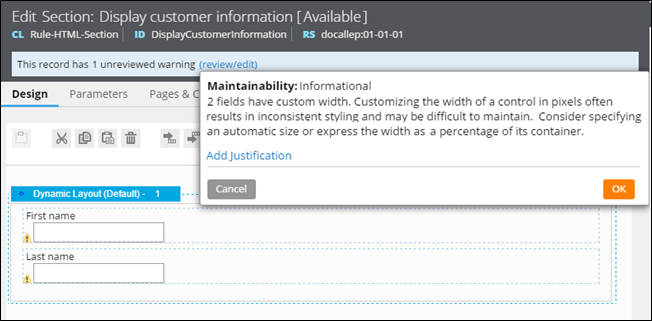Maintainable warning, error, and tip information
Valid from Pega Version 7.1.7
Use the redesigned Message form to define warning, error, tip, or custom category information in your application. Encapsulating these details in a message makes them easier to maintain and review. After you have created a new warning, you can quickly add it to a rule in your application using the new pxAddGuardrailMessage function.
For more information on the tabs and available fields on the Message form, see About Message rules.
Easy-to-browse warning catalog
Valid from Pega Version 7.1.7
All Pega 7 warnings have been converted to Rule-Message instances, each with a clearly written, risk mitigation path. This allows you to use the Records Explorer to browse through all warnings in the system, organized by category. To view warnings associated with specific rules in your application, refer to the Application Guardrails landing page.
Communicate guardrail compliance with the pxAddGuardrailMessage function
Valid from Pega Version 7.1.7
Now that guardrail warnings are in the model, you can easily attach them to rules in your application using the new pxAddGuardrailMessage function. Call this function to display warnings to your application users when they do not adhere to guardrails or best practices. Adopting this function in your application allows you to:
- Use localizable Rule-Message instances that are categorized by severity and application impact.
- Add dynamic warnings to your rules by passing parameters to a standard or custom message.
- Stop using and maintaining hard coded strings.

Design time view of warning messages

Run time view of an attached warning
This function supersedes the addWarning function, which has been deprecated. You can continue to use the CheckForCustomWarnings extension point, but it is recommended that you convert hard coded strings to messages and migrate any dependencies on addWarning to pxAddGuardrailMessage.
For more information on message attaching techniques, see Working with messages.
Track custom details with extensible messages
Valid from Pega Version 7.1.7
The customizable Message form gives you the freedom to expand upon default categories, store application specific data in a message, and enforce specialized validation. Leveraging these options makes it easier for you to identify a specific variety of message and incorporate new properties into your existing message processing logic.
For more details on which rules to override, see How to extend the Message form.
Collections more effectively model business decisions
Valid from Pega Version 7.1.7
Use the redesigned Collection form to model business logic or implement rule engine patterns in your application. This form is now located in the Decision rule category.
You can add response actions to each collection step to process return values transparently, and simplify your implementation by calling a function alias or when condition instead of an activity. Use one of the supported Stop methods to cease processing in the current collection or all collections in the call stack.
For more information on the available features on this rule form, see About Collection rules.
Existing collections are deprecated
Valid from Pega Version 7.1.7
The original implementation of the Collection form is deprecated. Legacy instances in your application remain functional; however, any new instance you create uses the redesigned Collection form. Use the Decision category in the Records Explorer to view all collections available to you.
For guidance on upgrade limitations, see the Deprecated Collection form.
Achieve traceability through mapped rule type parameters
Valid from Pega Version 7.1.7
Maintain thorough audit trails of rules processed in your application by mapping one or more function input parameters to key parts of rules called by a collection. Each association you define updates referencing rules by linking the specified rule and the collection that calls your function or an associated function alias.
For instructions on how create these mappings in the Rule Type Parameters section of the Function form, see Function form - Completing the Parameters tab.
Simplified parameter passing with functions and function aliases
Valid from Pega Version 7.1.7
After you have mapped a rule type on the Function form, you can pass a parameter page to it from a corresponding function alias. This simplifies your implementation by exposing parameter prompting to users anywhere that function aliases are supported, such as collections and when conditions.
For a procedure on how to pass parameter pages to mapped rule types, see How to use parameter pages with a function alias.
ShowWarningOnForm is no longer processed
Valid from Pega Version 7.1.7
Rule forms now display all warnings, independent of category or type. The standard decision tree Embed-Warning.ShowWarningOnForm is no longer used to determine which warnings are visible.
You can safely remove any specialized versions of this rule in your application.
Messages are rule resolved by class
Valid from Pega Version 7.1.7
As part of the Message form redesign, a class key part was introduced. While this key part is automatically handled as part of an upgrade or migration, it does change the available options you see in message SmartPrompts and how Rule-Message instances are rule resolved.
See Upgrade considerations for existing messages for more information.

